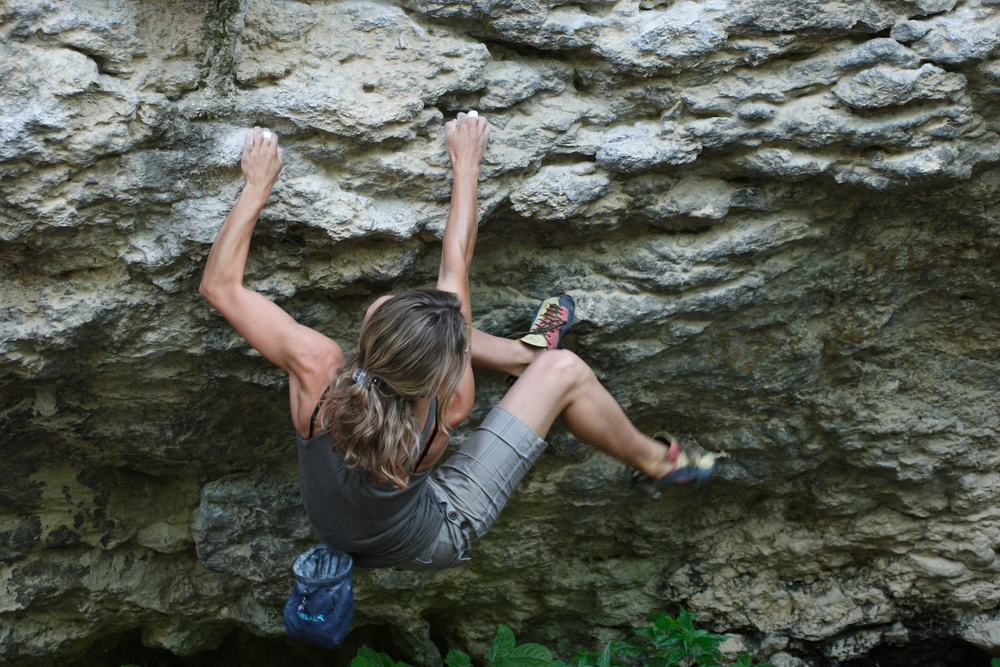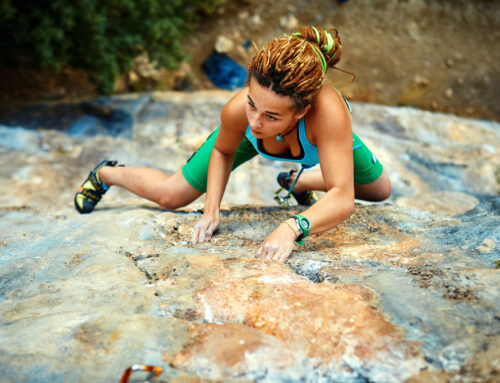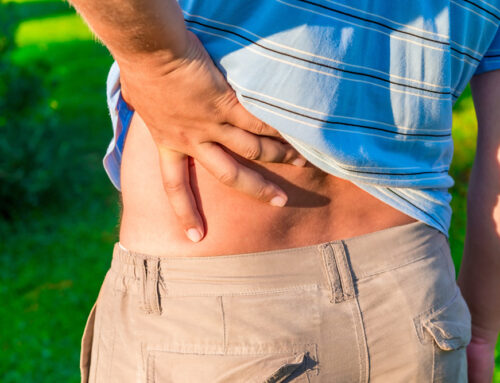Shoulders are a hot topic for climbers. Countless rock climbers run into trouble with their shoulders early in their climbing careers, after many years of climbing hard, or once they’re older and no longer training regularly.
When I’m in the climbing gym, I always like to observe the postures and movement patterns of the people around me. It sheds light on why so many climbers develop shoulder issues. Over the years, I’ve had many opportunities to help climbers overcome these issues through acupuncture, manual therapy, and rehabilitative or preventative exercises.
How the shoulders work
The shoulder joint has tremendous range of motion to allow you to reach into all kinds of positions, something that your hip joints don’t accomplish as easily. This is mainly a result of anatomical differences: the humerus (the large bone in your arm) sits in a very shallow socket, while the femor (the large bone in your thigh) is held in the deeper socket of your hip joint. This means that the stability of your shoulder joint depends more on healthy balance of the surrounding soft tissues, esp. tendons and ligaments, to stay where it belongs while you move through the full range of motion.
The labrum is a ring of cartilage that enlarges the shallow shoulder socket (glenoid fossa) to hold the head of the humerus; it also functions as a suction cup to keep the humerus in place. Around this joint are four important, yet relatively small muscles whose tendons, along with an array of ligaments, hold the joint together. This muscle group is referred to as the rotator cuff and comprises the supraspinatus, infraspinatus, teres minor and subscapularis (SITS muscles). These four muscles work together to move the arm into all kinds of different positions. They’re aided by the deltoid and a few other muscles.
But there’s more
Easy to overlook is the fact that these muscles use your shoulder blades (scapulae) to anchor your arms to your torso. The scapulae are instrumental in transmitting force from your core and provide stability. Consequently, we refer to the muscles that connect the scapulae with your ribcage as the shoulder stabilizers. They include the trapezius, rhomboids, levator scapulae and serratus anterior, as well as the pectoralis minor in the front of your ribcage.
And that’s where we get to the crux. Because these so-called shoulder stabilizers are out of sight, they’re usually out of mind for many climbers. We have a tendency to develop strong muscles on the front of the body and arms but neglect to equally train the muscles we can’t see. The result is that the front of the chest contracts, in particular the pectoralis muscles, your shoulders roll forward, your arms turn inwards, and you develop a hunch back.
This creates enormous imbalances between the front of your body and the backside. Not only does your chest collapse and impede full expansion of your lungs when you’re breathing, but your rotator cuff and shoulder stabilizer muscles become weak and overstretched. This is essentially an imbalance between agonist and antagonist muscle groups. In theory, any muscle can be an agonist or antagonist, depending on the function it performs at any given moment. In the case of climbers, the muscles on the front of the chest and arms function as agonists most of the time.
Putting these insights to work
To improve the balance between your climbing agonists and antagonists, the following three-part strategy can be useful: (1) postural awareness; (2) stretching; and (3) strengthening.
You can develop postural awareness by working with a partner or using large mirrors to assess your posture. Notice when you look at yourself in profile how your upper back is rounded and your shoulders trend forward. Allow the tops of your shoulders to relax and gently bring your shoulder blades together and let them slide down your back a bit. As a result, the outside corners of your shoulders should now be more in a plane with your torso and you should feel a slight expansion in the front of your chest. Your head may now also be better balanced above your spine.
Stretching should focus on the muscles that do most of the work when you climb. Focus on the pectoralis muscles on the front of your chest, the biceps and any tight muscles around your neck. Gentle, passive stretches that use just gravity and your breath to expand the chest are preferable. Stretching takes patience and needs to be part of your daily routine. If you find that any particular areas or muscles feel sore or tight, you can use homemade wheat bags warmed up in your microwave to soothe and relax these soft tissues before and while you’re stretching. Think of stretching as a relaxation treat!
Strengthening exercises to balance your shoulders should emphasize those muscles that anchor your arms to the torso, i.e. your shoulder stabilizers. You don’t need a lot of gear to develop a routine. A couple of small free weights, an exercise band, and access to a bench or just an exercise mat and large foam roller will be enough to get you started.
Some of my favorite resources
Here are a few resources for exercises: One of my favorites is the Buchberger 12, which was developed a number of years ago by Dale J. Buchberger, a former professor at New York Chiropractic College. You can buy his books and videos at Shoulder Made Simple. You can also download a free three-page PDF from Third Space Medical that describes the sequence. I also really like the videos produced by physical therapist Dr. Esther Smith and pilates instructor Eva Kauffman of Grassroots Self Treatment in Salt Lake City, for example Healthy Shoulder Video. Esther’s creds include working with the Black Diamond pro team.
Get professional help early
If you are already experiencing pain in your shoulders, you need to slow down and find out what’s wrong. Initially, a good clinical exam by a physiatrist, orthopedist, chiropractor or sports acupuncturist will give you an idea what structures may be affected. Imaging such as ultrasound, radiography or magnetic resonance may be necessary to identify (or rule out) tears or other damage. Pain may be caused by fractures, tears, bursitis or, more commonly, by fascial constrictions and trigger points in the muscle bellies.
Try to avoid pain medications such as NSAIDs, cortisone injections and surgery unless you are certain that other strategies such as acupuncture, chiropractic or physical therapy are insufficient to resolve your injury. Also consider that you may be developing arthritis (even if you’re still pretty young) because of systemic inflammation in your body facilitated by dysfunction of your gut flora, i.e. your microbiota. If this could be a factor, we can use a functional medicine approach to treat the root cause of your pain.
This is a lot of information to digest, but if you love climbing you need to take good care of your body (and mind), and this all starts with developing a better understanding of the physiology of climbing. Fortunately, more and more injury prevention articles, books and videos have recently become available to educate climbers, and some doctors of conventional and integrative medicine are now focusing on climbing injuries. So, get off your duff!
© 2023 Christiane Siebert








Leave A Comment